Lien Khu IV (Administrative District IV, North Annam) was located just South of Hanoi and ranged roughly until Da Nang in Central Vietnam.
Lien Khu V (Administrative District V, ) was located South of Da Nang and ranged until just North of Saigon.
Lien Khu VI (Administrative District VI) was located at the very bottom of South Vietnam.
These administrative districts were semi-autonomous as they were basically cut-off from from the region surrounding Hanoi (Lien Khu III, West Tonkin) and the mountain regions located East of Laotian border (Lien Khu I) and South of the Chinese border (Lien Khu II). Because Viet Minh stamps from the Central Government that controlled most of the countryside in the North could often not be transported to Lien Khu IV through VI and because the French military was still controlling all the major transit routes these areas had to come up with their own stamps. This was sometimes done by overprinting Viet Minh stamps or stamps of the old Indochinese Regime that were on hand with new values. Inflation was rampant and so this was required frequently. Also, let’s keep in mind that the Ho Chi Minh Trail that ran through Laos and Cambodia did not exist yet to the same degree it existed during the war with the U.S.. Postal rates in Lien Khu IV through VI did not neccessarliy match those of the Viet Minh postal system in the North.
Lien Khu IV
Indochinese Stamps that were previously overprinted by the Central Viet Minh Government but then overprinted by the Lien Khu IV Government with new values. According to Michel four values were overprinted anew:
0.30D on 15 Centimes (Democratic Republic of Vietnam Nr. 20) overprinted on Indochina Nr. 345 with “BDLKV 4 Gia Moi 0 d 30” (=Postal Service of the 4th Interzone) in green. Here is a vertical pair of two mint stamps (ex Schwirtz).
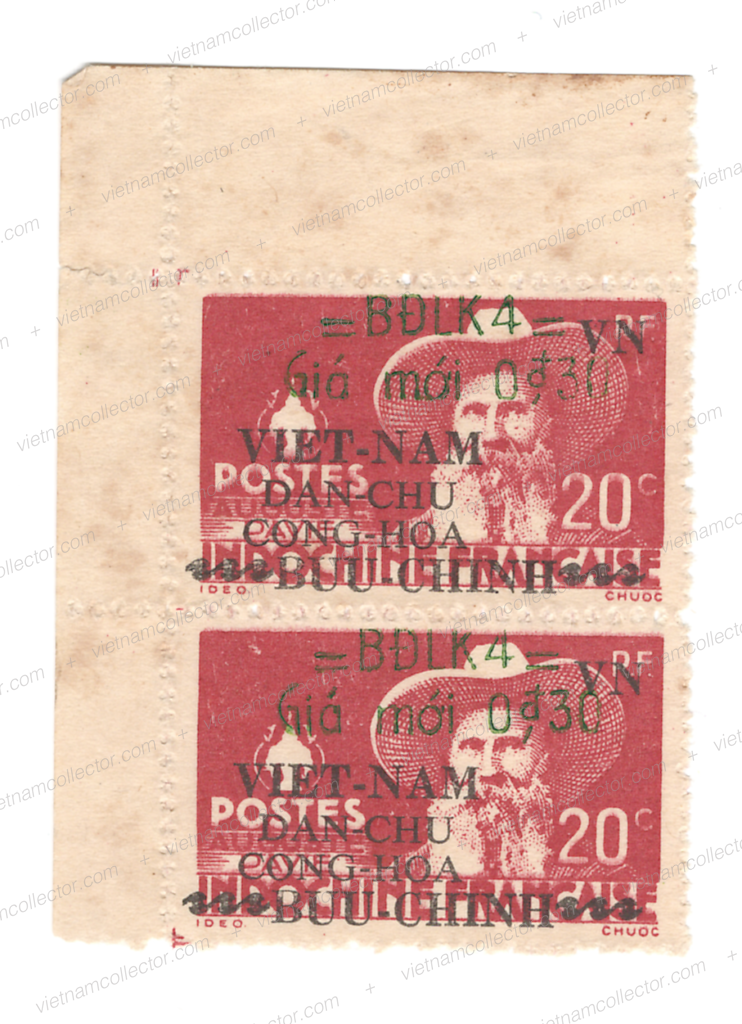
0.50D on 30xu (Democratic Republic of Vietnam Nr. 30) overprinted on unissued Indochina Nr. II with “BDLKV 4 Gia Moi 0 d 50” (=Postal Service of the 4th Interzone) in black. Here is an exceedingly rare used specimen (ex Schwirtz) that shows a cancel that certainly looks genuine which indicates that these stamps were in fact postally used.
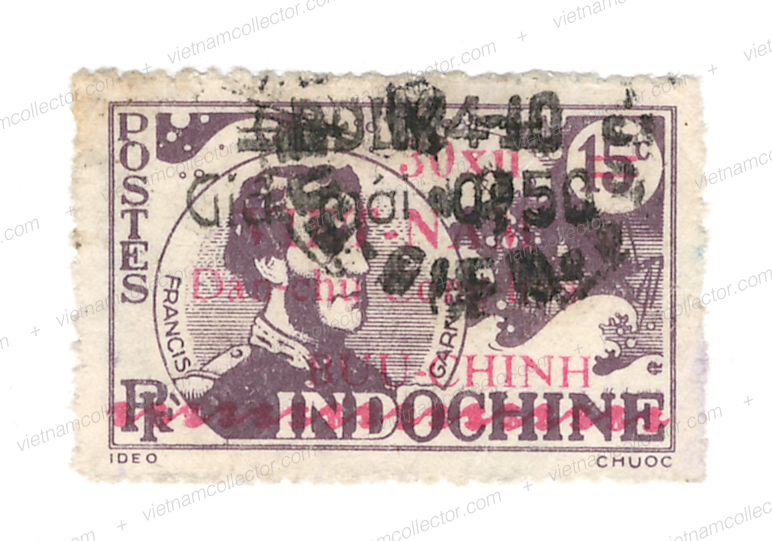
Here is the same manual overprint of “BDLKV 4 Gia Moi 0 d 50” (=Postal Service of the 4th Interzone) in red on the base stamp Indochina Michel Nr. 344. This is unusual as this overprint was normally applied to stamps by the Viet Minh that had already been overprinted with “Viet-Nam, Dan-Chu, Cong-Hoa, Buu-Chin”. This variety is not listed in any catalogues at this time but has been reported to Michel for future inclusion.

Michel Nr. NZV 3; 0.50D on 2 Centimes (Democratic Republic of Vietnam Nr. 2) overprinted on Indochina Nr.321 with “BDLKV 4 Gia Moi 0 d 50” (=Postal Service of the 4th Interzone/New Price) in black. Here is a horizontal mint pair of this stamp (ex Schwirtz).
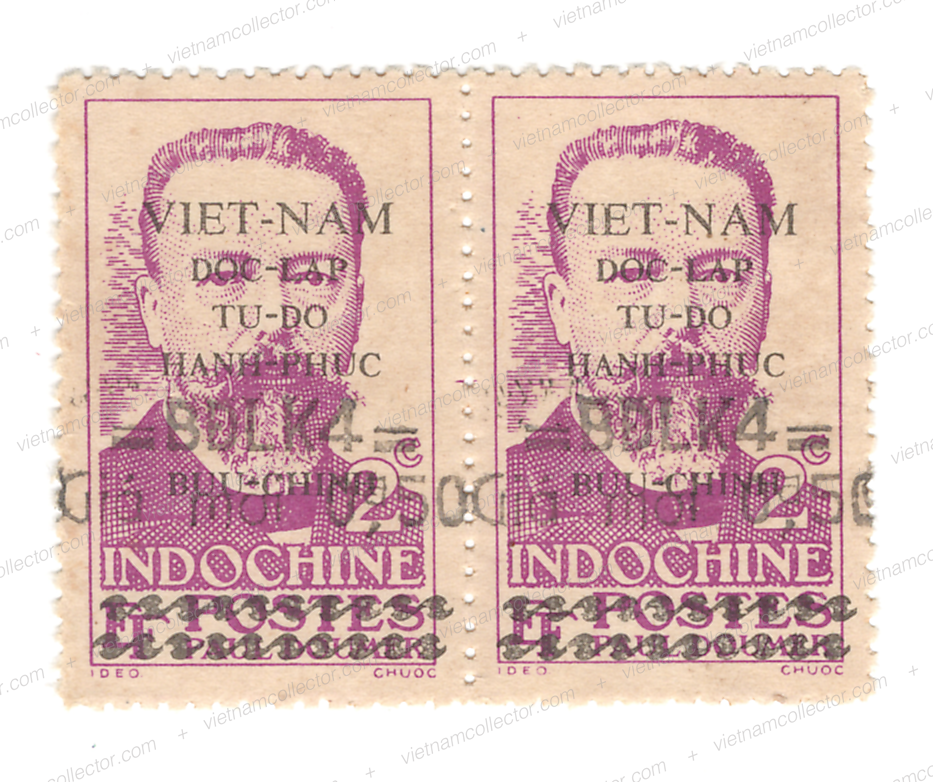
Michel Nr. NZV 4a; 0.50D on 15 Centimes (Democratic Republic of Vietnam Nr. 19) overprinted on Indochina Nr.344 with “BDLKV 4 Gia Moi 0 d 50” (=Postal Service of the 4th Interzone/New Price) in black. Here is a mint version of this stamp (ex Schwirtz).
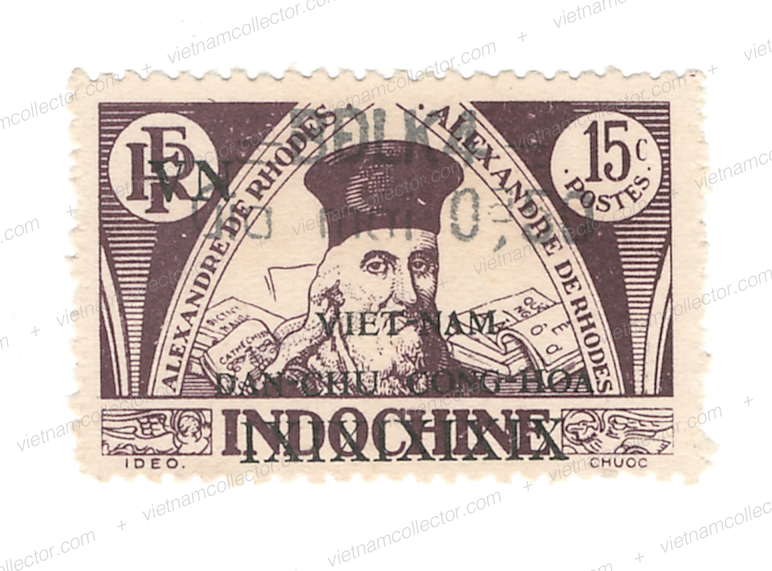
Michel Nr. Unlisted ; 0.50D on 15 Centimes (Democratic Republic of Vietnam Nr. 19a) overprinted on Indochina Nr.321 with “BDLKV 4 Gia Moi 0 d 50” (=Postal Service of the 4th Interzone/New Price) in black. This overprint on the green Viet Minh overprint is not yet listed in the Michel catalogue. Here is a rare pair in mint (ex Schwirtz).
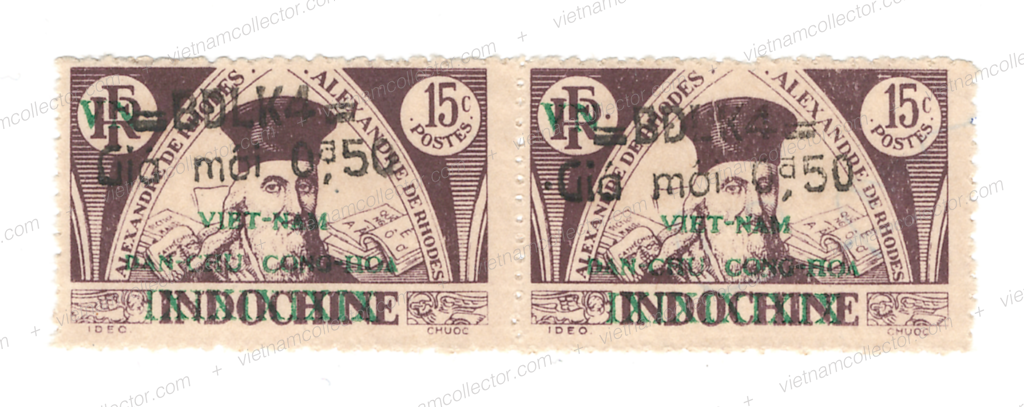
Michel Nr. NZV 4b ; 0.50D on 15 Centimes (Democratic Republic of Vietnam Nr. 19) overprinted on Indochina Nr.321 with “BDLKV 4 Gia Moi 0 d 50” (=Postal Service of the 4th Interzone/New Price) in red. Here is a rare vertical pair in mint (ex Schwirtz).
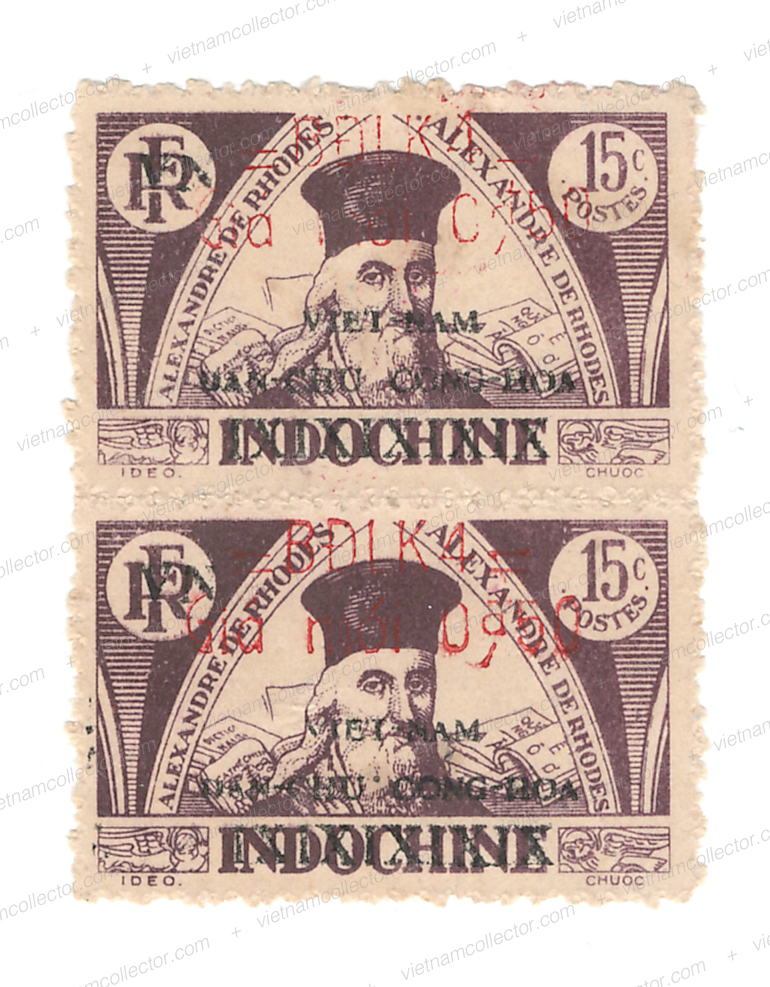
Michel Nr. NZV 4c ; 0.50D on 15 Centimes (Democratic Republic of Vietnam Nr. 19) overprinted on Indochina Nr.321 with “BDLKV 4 Gia Moi 0 d 50” (=Postal Service of the 4th Interzone/New Price) in red-brown. The editor has never seen the re-brown overprint and suspects it may simply be an oxidized version of the red overprint above or reflects a hand-stamp that previously was used with black ink and subsequently with red ink mixing both colors.
A 0.50D on 30 Centimes (Democratic Republic of Vietnam Nr. 21aA) overprinted on Indochina Nr.315b with “BDLKV 4 Gia Moi 0 d 50” (=Postal Service of the 4th Interzone/New Price) in blue is in the collection of a fellow SICP member and the overprint looks genuine. This stamp is yet unlisted in Michel and has not been collected by the editor yet.
There is also a forgery of the red overprint in what appears to a neon color that was not even available in 1946/7. The overprint is much cruder than the genuine overprint. Also Ha Giang was located in the North West just South of the Chinese border in Lien Khu II. Here is a sample of the forgery.
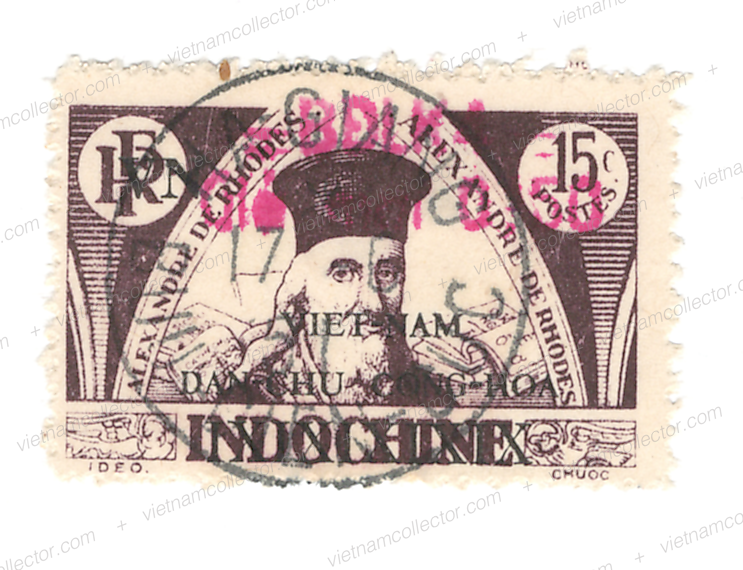
Another overprint type has been found that is also attributed to Lien Khu IV. It states “Viet Nam, Dan Chu, Cong Hoa, 50xu VN” is printed in red and the overprint is found on Indochina Michel Nr. 291. Given the 0.50D nominal it would have to fall into the same time period as the above stamps (Fall of 1947 to January of 1948). The stamp has so far only been observed mint so it is not known if this stamp was ever released or if it is even an official issue of Lien Khu IV. Michel list it under NZV I.
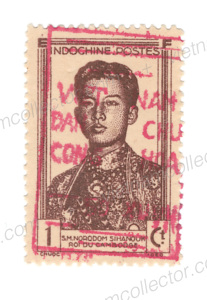
Michel Nr. NZV 1-4 are all significantly more scarce than what the Michel price suggests. Also the editor questions the Michel prices for used stamps. Virtually all the genuine stamps the editor has ever seen are mint and he is only aware of the above genuinely used stamp. All other used stamps have the typical corner CTO cancel that is impossible to verify. These were most likely applied with stolen cancels much later. If you have any genuinly used stamps which show city and date, the editor would be very interested to receive a scan copy of them.
The Viet Minh postal tariff changed in the fall of 1948 from 1.5 Dong to 5 Dong and the 9 Hao value of the 1st Ho Chi Minh series from September of 1946 (Democratic Republic of Vietnam Nr. 19) was overprinted with a new value 5 Dong and Gia Moi (= new price) in black. There are three different overprint types known. While the editor has never seen a complete sheet of these stamps or even a large unit, it is likely that these different types all appear within the same sheet and simply represent different overprint cliches. The same can be observed with Michel NVN Nr. 1. These stamps have yet to be seen postally used or on cover suggesting they represented trial prints that were later rejected and ended up in the archives from which they were sold after the war. All cancelled stamps seen so far have a mostly illegible corner cancel that likely stems from cancelers that were stolen after the war.
Here is the mint version of Michel Nr. NZV 5a Type I).
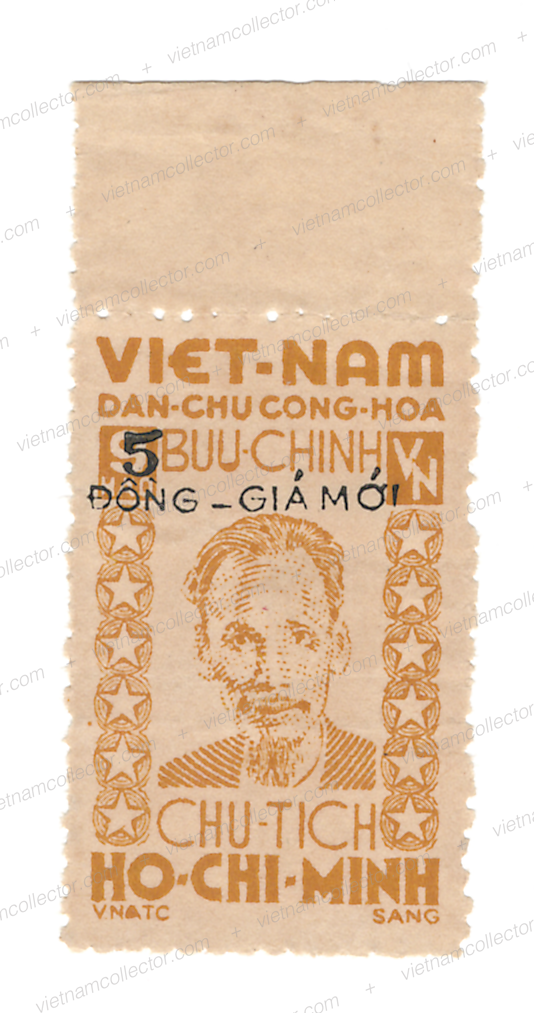
Here is a cancelled version of Michel Nr. NZV 5a Type I) but the corner cancel looks very much like a cancel to order that was applied with stolen cancel outside the time period.
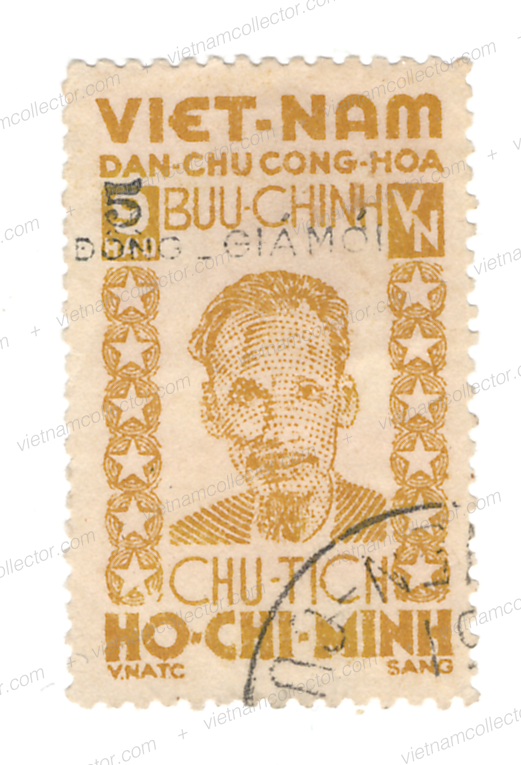
Here is the mint version of Michel Nr. NZV 5b Type II).
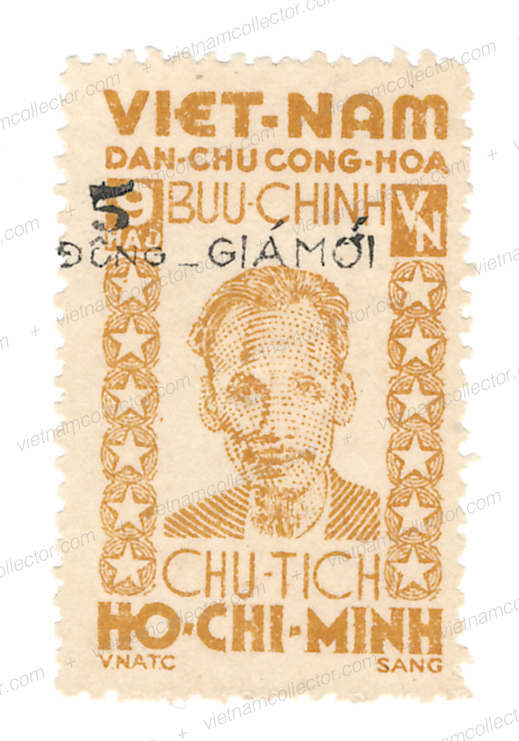
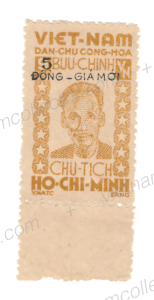
Lien Khu V (created July/August, 1951)
After the editor discovered a so far unknown LKV stamp (see ICP Nr. 222), it occurred to him that until now, no global inventory of these stamps exists. All we knew so far is that they are very rare; but their relative scarcity among the different values and the relationship between mint and used stamps was so far not known.
Of course the question was, how to go about that. A good start was to look at the accumulations by reputable philatelists who started to collect these stamps early on, right after they were issued, and at a time they were essentially unknown to the philatelic community at large. Here just three names came to mind; Tran Trong Khai, and former SICP members Jacques Desrousseaux and Theo Klewitz.
Les Postes et Courriers Francais en Extreme-OrientJACQUES DESROUSSEAUX
Khai used to maintain a website (unfortunately, now defunct) that displayed a large number of these stamps. Luckily, the author printed out the display of the LK V stamps in the past and used it as a start for the count. He then approached SICP members Frank Duering, who was kind enough to contribute all the LK V stamps collected by Klewitz which are now in his collection, plus any stamps he had since acquired, traded or documented from different sources. SICP member Lucian Lu also contributed his knowledge. He, at one time, has handled or owned many of the LK V stamps in existance and hence provided reliable evidence on quantities currently owned by Vietnamese and Chinese owners. In addition, he looked at the LK V stamps that Jacques Desrousseaux had published in 1991, in his 6th book for COL.FRA called „Les Postes et Courriers Francais en Extreme-Orient“. Other sources were Jean Goanvics website (http://www.histoire-et-philatelie.fr), stamps that were included in the fellow SICP member Jack Dyhouse’s collection, sold in Switzerland a few years ago, the stamp in David Foster’s collection, stamps that had been offered in public auctions in recent years, plus all the stamps in the author’s collection. Worthy to mention, but not in consideration were the stamps in the Kahane collection, also sold in Switzerland a while back, as the the scans were of poor quality and hence it was impossible to ensure that they actually were genuine. The fact that said collection contained numerous fake LK V stamps gave the author additional reason to be cautious.
Of course a lot of stamps have changed hands over time. Father Linh Bui once owned a number of LK V stamps that he acquired from Tran Nguyen, a fomer postmaster from North Vietnam. After he emigranted to California he then sold them to fellow SICP member Lucian Lu[1], who then passed them on to the author and other collectors in Vietnam, California and China. As a result, there is a lot of duplication when one looks at all the records. Luckily, most of these stamps are so unique (due to their cancels, faults, the way they are cut and their variable print), that it was fairly easy to recognize them and avoid any double counts.
Here is the current count based on the sources indicated above:
| Michel Nr. | Nominal Value | Color | # Mint | # Used |
| 1 | 1 Dong | Violet-Grey | 11 | 10 |
| 2 | 5 Dong | Dark Green | 5 | 25 |
| 3 | 10 Dong | Green-Blue | 0 | 6 |
| 4 | 10 Dong | Lilaq-Rose | 1 | 7 |
| 5 | 15 Dong | Brown | 2 | 8 |
| 6 | 30 Dong on 5 Dong | Dark-Green | 2 | 13 |
| 6A | 50 Dong on 15 Dong | Brown | 0 | 1 |
| 7 | 60 Dong on 1 Dong | Violet-Grey | 3 | 4 |
| 8 | 100 Dong | Light-Green | 0 | 4 |
| 9 | 200 Dong | Orange-Red | 0 | 4 |
| 10 | 300 Dong | Blue | 0 | 3 |
| 11 | 500 Dong | Red | 0 | 1 |
| D1 | 0.050kg Rice | Pale-Red | 0 | 5 |
| D2 I | 0.300kg Rice | Pale-Red | 0 | 4 |
| D2 II | 0.300kg Rice | Pale-Red | 0 | 7 |
| D3 | 0.300kg Rice | Matte-Violet | 0 | 13 |
| D4 | 0.600kg Rice | Blue-Green | 0 | 3 |
| D5 | 0.600kg Rice | Violet-Blue | 0 | 2 |
| D6 | 1.000kg Rice | Green-Olive | 0 | 3 |
| D7 | 0.300kg Rice on 30 Dong on 5 Dong | Dark Green | 16 | 11 |
| D8 | 0.050kg Rice on 300 Dong | Blue | 0 | 3 |
| D9 | 0.300kg Rice on 15 Dong | Brown | 0 | 1 |
| Total | 38 | 138 |
Michel D9 is listed in red in the table as the author has so far only seen a foto of this stamp. It has all the characteristics of a genuine stamp. It was acquired by ist current owner 30 years ago in Vietnam. He has requested a high quality scan from the owner in order to verify ist authenticity and report it to Michel for listing.
The service stamps Michel Nr. I, II and III were not included in this table as the official character of these stamps is in question. So far, none of these stamps have been documented on genuine letters of the period or with genuine cancels in use at the time in the LK V area. Known examples are either mint or show fake or favor cancels without date or year. Also the low 0.05kg nominal makes little sense for the time period as the standard letter rate already stood at 0.300 kg rice. It is very likely that this overprint is simply a fantasy production that was produced after the war to defraud collectors. Please note that this stamp is sometimes offered with a forged inverted overprint. It is easily recognizable by the slightly higher horizontal level of the “5” in relation to the “O” that stands before. In the “original” overprint, which may very well also be a fantasy product, the “5” and the 0″ are on the same level.
Service Stamp Michel Nr. SZV I cancelled to order with likely mis-used cancel.
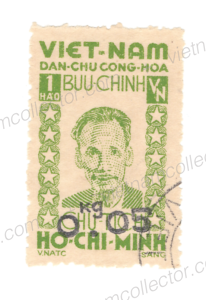
Service Stamp Michel Nr. SZV III (the “LKV” overprint represents a forgery that was added at a later time than the nominal overprint as evidenced by the different overprint color). While the 0.25kg overprint makes technically more sense when looking at the standard letter rate of 0.30kg rice the stamp has yet to be seen postally used or on cover.

The author does not represent that the above count is complete and an accurate reflection of all LK V stamps in existance. Clearly, it is to be expected that some specimen, lie in collections that have not seen the light of day for a long time or in the collection of very private philatelists who prefer their material not to be known to the public. However, given the fact that most stamps that were passed on over the past 50 years from the original collector generation to later collector generations remain essentially the same, and that hardly any „new“ inventory of these stamps come to the market, as witnessed by the author’s over 20 years of studying collection websites and public auctions, it is also fair to assume that this „unknown“ inventory is not very large.
Interesting but not necessarily surprising is the finding that, generally, the number of mint stamps is much lower than the inventory of used stamps and that of many issues not even a single specimen was preserved in mint condition. One has to understand that these stamps were not produced for collectors, but they represent local issues for South-Central Vietnam, that became necessary, because the LK V area controlled by the Viet Minh was temporarily cut off by French troop intervention and so no supplies of the Ho Chi Minh stamps (NVN Michel Nr- 2 to 6), in use in the North at the time, could be supplied to the area for quite some time[1]. LKV was established in July/August 1951 on a consolidated basis of Regions 5 ,6 and 15 (Highlands subdivision). LKV included Quang Nam , Da Nang , Quang Ngai , Central Highlands (Gia Lai , Kon Tum , Dak Lak , Lam Dong) , Binh Dinh, Phu Yen and Khanh Hoa (Nha Trang) . Hoai Nhon (Binh Dinh) was the ” capital ” of the LKV .[2]
Unique strip of five. Largest known unit of this stamp. Paper fold between second and third stamp from the left. Small stains at bottom left, bottom and top of the first stamp on left. Stain at bottom of fourth stamp from the left. Small stain to the right shoulder of HCM and bottom right of the fifth stamp from the left. Hinge traces on the first and fifth stamp but no paper thins. Paper shows tropical toning. Provenance: Tran Nguyen (former Postmaster of North Vietnam), Tran Trong Khai, Father Linh Bui, Lucian Lu (SICP member), Gebhardt (SICP member).
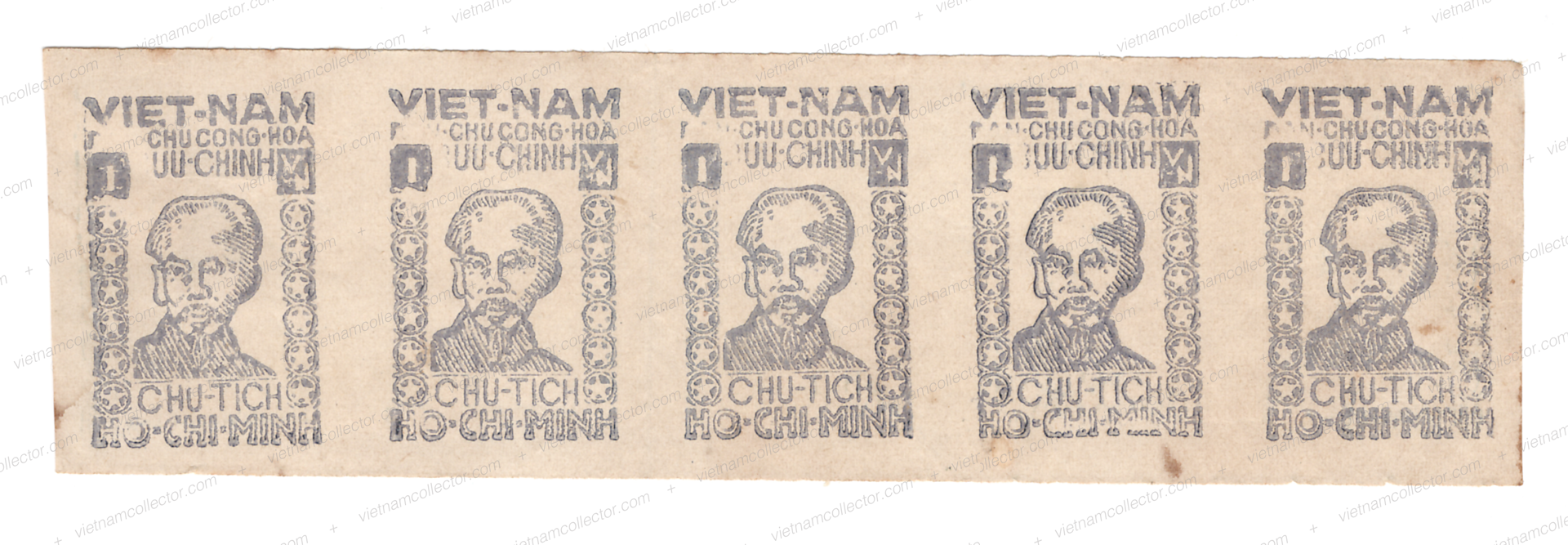 In counting the used stamps, the author did not distinguish between stamps on or off cover. They were all counted as used. Also, the author did not eliminate any damaged stamps from the count. Based on damage that is visible from the front of the stamps, about 20% of the total inventory shows imperfections. The postal officers that cut or tore these stamps from the sheets were not particularily careful. Often some part of the design was simply cut or torn off, although the clear space beetwen the stamps in the sheet was actually pretty large. Some stamps received the same treatment when envelopes were opened by scissor. It is to be expected that additional imperfections (paper thins) were created when the stamps affixed by a starchy rice glue were taken off cover unprofessionally. Clearly, damaged stamps do not hold the same value as sound copies, but it would be highly imprudent to reject such stamps entirely for one’s collection by applying preservation standards for stamps that were produced and used under much less challenging conditions. Let’s keep in mind that quite a number of these LK V stamps are rarer than the fabled Blue and Red Mauritius stamps (12 and 15 surviving copies respectively, mint and used)! Some of the issues (Michel Nr. 6A, 11 and D9) so far are actually as rare as the worlds most expensive stamps, the British Guyana 1 cent magenta that sold for $9,480,000 in 2014 and Sweden’s Tre Skilling Banco misprint that sold for SFR 2.88 million (approximately U.S.$2.3 million) in 2010![3]
In counting the used stamps, the author did not distinguish between stamps on or off cover. They were all counted as used. Also, the author did not eliminate any damaged stamps from the count. Based on damage that is visible from the front of the stamps, about 20% of the total inventory shows imperfections. The postal officers that cut or tore these stamps from the sheets were not particularily careful. Often some part of the design was simply cut or torn off, although the clear space beetwen the stamps in the sheet was actually pretty large. Some stamps received the same treatment when envelopes were opened by scissor. It is to be expected that additional imperfections (paper thins) were created when the stamps affixed by a starchy rice glue were taken off cover unprofessionally. Clearly, damaged stamps do not hold the same value as sound copies, but it would be highly imprudent to reject such stamps entirely for one’s collection by applying preservation standards for stamps that were produced and used under much less challenging conditions. Let’s keep in mind that quite a number of these LK V stamps are rarer than the fabled Blue and Red Mauritius stamps (12 and 15 surviving copies respectively, mint and used)! Some of the issues (Michel Nr. 6A, 11 and D9) so far are actually as rare as the worlds most expensive stamps, the British Guyana 1 cent magenta that sold for $9,480,000 in 2014 and Sweden’s Tre Skilling Banco misprint that sold for SFR 2.88 million (approximately U.S.$2.3 million) in 2010![3]
30D on 5D used with circular but illegible canceler. Wide margins. Small paper thin on back at bottom left. Provenance: V.Longin (France), Gebhardt (SICP Member).

When looking at the only catalogue that list LK V stamps (Michel Suedostasien 2015), it becomes clear that some work will have to be done with the catalogue maker to reprice these stamps. Here, it will be important to not only look at the relative number of stamps that still exist, but also, at their state of concentration. Michel Nr. 1 is a good example for this. While there are 11 stamps mint and 10 used, in existence, these stamps are highly concentrated in 3 items. All used copies are on a single letter and no one would ever dream of taking these stamps off. The mint stamps exist in one strip of 5 (Exhibit 1), one strip of 3, and three single stamps. Again, no reasonable philatelist would ever cut apart a unit, as there are only 3 mint units left overall that have more than one stamp. A similar situation exists with Michel Nr. 3 where 3 of the 6 used stamps are found on a single cover; and to a lesser degree Michel Nr. 6 (Exhibit 2) where 10 of the 13 used specimens are on a single letter. Clearly these concentrations have to be taken into consideration. Also, the absolute amounts these stamps are currently priced at need to be looked at. While the most recent catalogue has seen some long overdue increased revision in prices, one has to ask if €5,000 is really enough for a stamp that only exists in a single copy. Of course prices are determined by the market that balances supply and demand. The problem here is that until now, the market had no transparency how many stamps survive. Also,single LK V stamps hardly ever come to market (often, they move from one collector to another in a private transaction) and hence, there is no public record of the prices paid. Finally, the flood of fake LK V stamps produced in Vietnam and most likely Hong Kong, still offered, by reputable, but ignorant auction houses, have created a great deal of insecurity among Vietnam stamp collectors who are understandably reluctant to buy yet another fake for a lot of money.
In the opinion of the author, this problem can only be solved by publishing a booklet under the helm of the SICP that eventually contains and describes all copies of LK V stamps in existence. Clearly, we have among our members the world’s top experts on the subject, and documenting each copy (including its condition and provenance as far as can still be determined) in such a publication (which we should make available on the free part of our website) would go a very long way to take out the uncertainty for potential buyers. Only then would we be able to see how the market truly values these stamps. This will of course take the cooperation of all the owners of these stamps and that is not an easy undertaking. The author welcomes any comments from the membership about this subject, information on additional holdings that may not be considered yet in the above table and, of course, he would be delighted to receive high quality scans of your holdings that could be used for such a publication.
The author believes that the voices of some philatelist, that none of these stamps should ever be shown in public as this would only attract additional and better fakes, are misguided. These stamps are not easy to fake as everyone, who ever has seen genuine and fake stamps side by side, can attest to. The way the color is absorbed by the paper, the imprecise stone print that differs a bit from stamp to stamp and the paper itself is very hard to imitate. Also, since most copies are in fact used and have very characteristic cancels, creating convincing duplicates becomes even harder.
Here are the additional genuine stamps that are in the editors collection.
5D mint with hinge. Small thin below hinge. Some age stains on the back (middle right). Provenance: Vaclav Fejtek (Czech collector), D.Schwichtenberg (Daughter of Feijtek), Gebhardt (SICP Member)
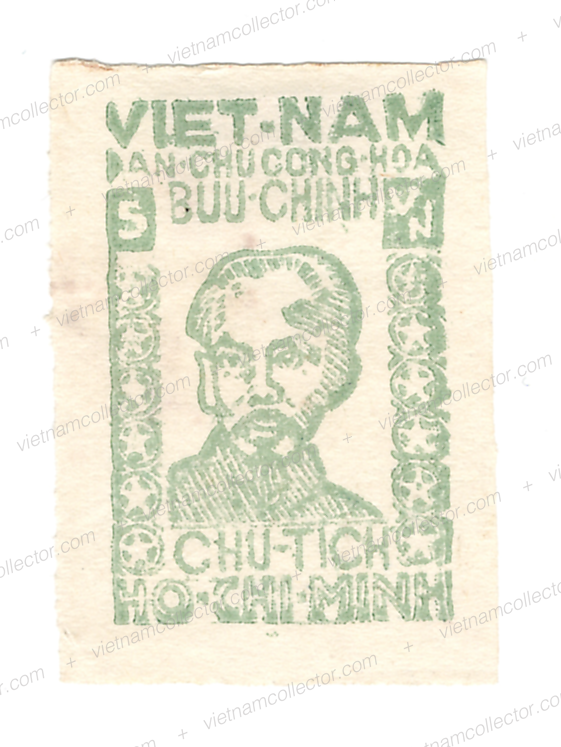
5D mint with hinge. Small age spot top right margin. Provenance: Vincent Longins, France, Gebhardt (SICP Member)
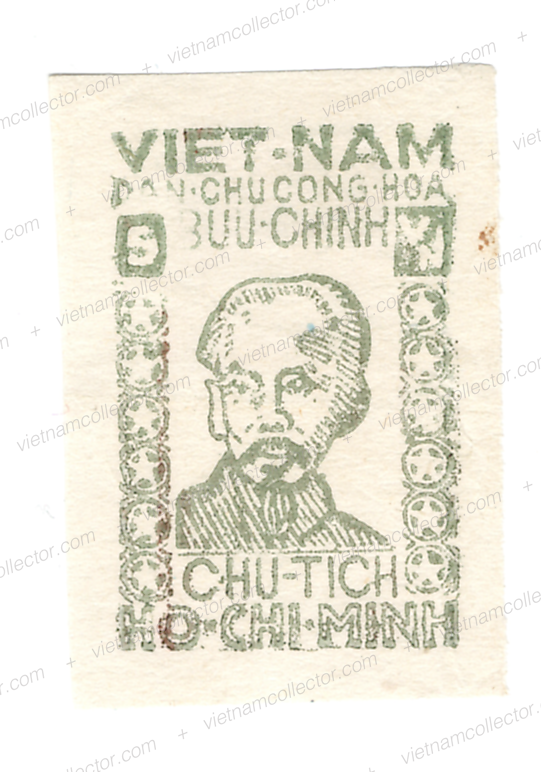
5D used, rectangular Buu Dien cancel illegible (Thanh-Hoa?). Tight margins but not touching the image. Tiny pin prick hole just below “5”.
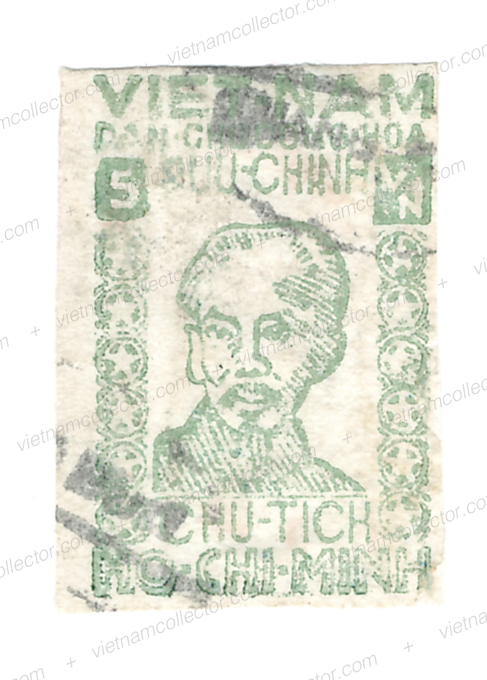
5D used, circular cancel “Phong Bat Biet”. Cut on the left just touching the print image. Small thins on back in center and at top of the stamp. Provenance: V.Longin (France), Gebhardt (SICP Member)
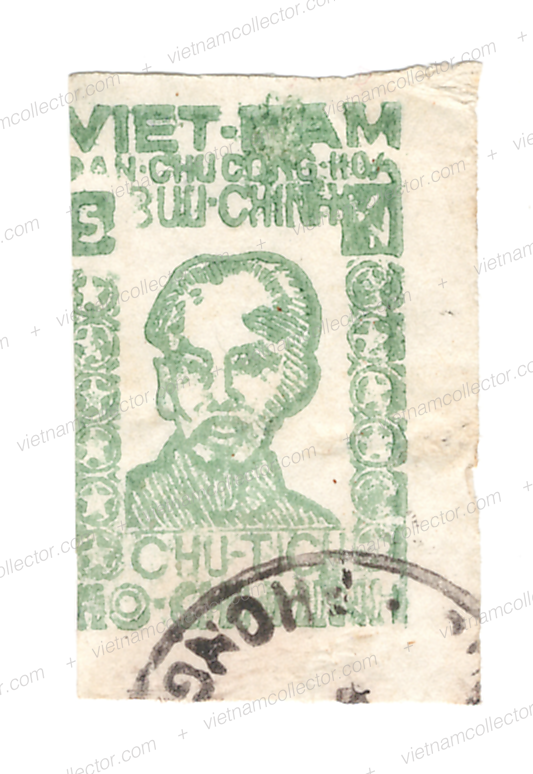
5D Block of four on piece. Largest known unit of this stamp. Cancelled with circular Hoai Nhon Buu Dien canceler and manual insertion of date. In addition, rectangular date cancel showing 2.12.50. This is evidence that these stamps were produced and used already in 1950. Bottom left stamp surface abrasion on top of stamp eliminating “NA” in “Vietnam”. Bottom right stamp showing larger surface abrasions on the right side of the stamp. Provenance: Tran Nguyen (former Postmaster of North Vietnam), Tran Trong Khai, Father Linh Bui, Lucian Lu (SICP member), Gebhardt (SICP member).
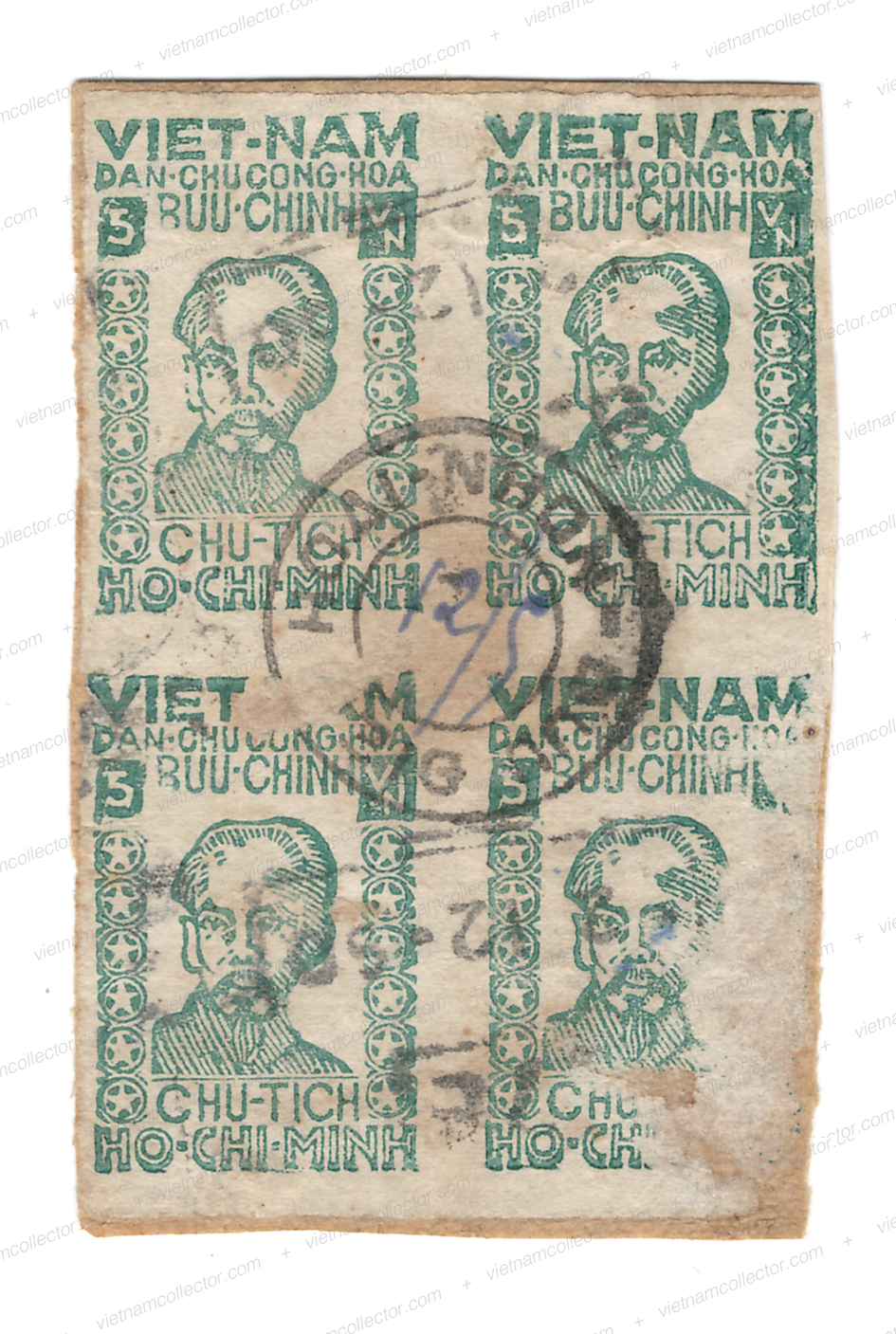
30D on 5D mint with hinge. Tiny pin prick at middle/bottom of image. Provenance: Vaclav Fejtek (Czech Collector), D.Schwichtenberg (Daughter of Feijtek), Gebhardt (SICP Member)

Used with illegible circular cancel. Stamp was initially missing a small art of the design “M” in Vietnam and “VN”. Expertly restored. Some margin added to right side. Provenance: V.Longin (France), Gebhardt (SICP Member).
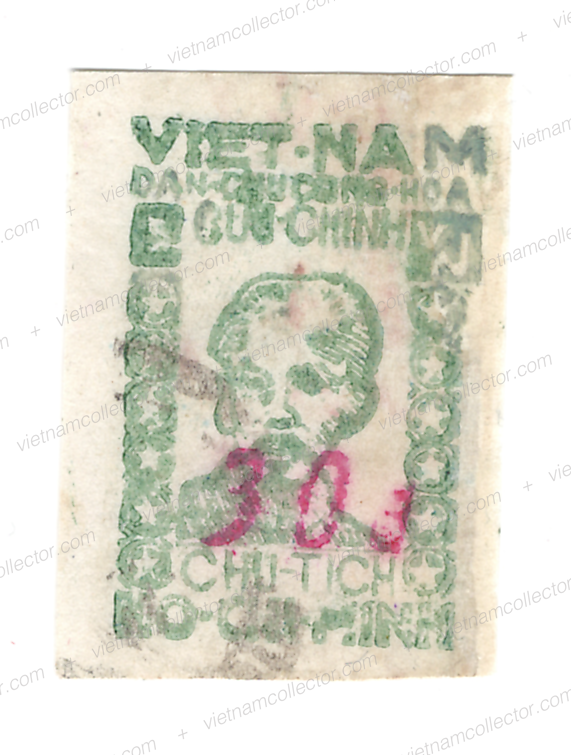
50D on 15D used with circular date canceler from Hoai Nhon on June 15th(1952?) and blue pen manuscript. Only known specimen of this stamp. Small tear on top right, barely affecting the image. Larger paper thin on back at the top. Provenance: V.Longin (France), Gebhardt (SICP Member).
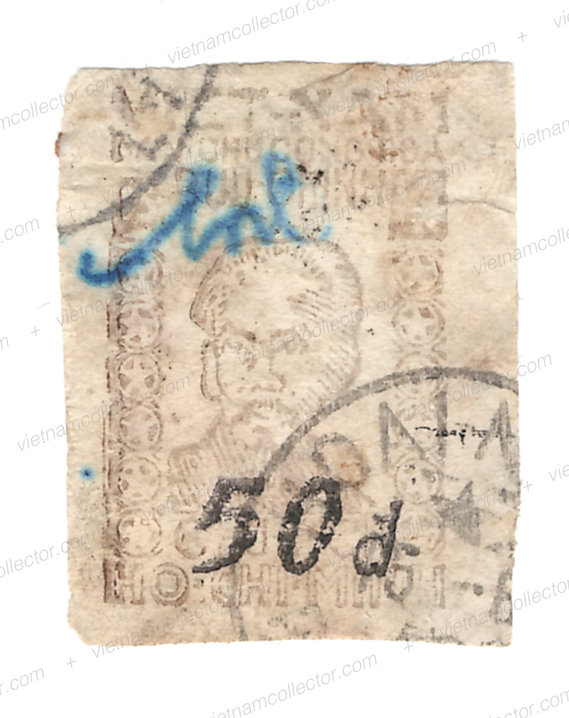
100D used with cancel fragment showing “Ngay” and “54”. Horizontal paper fold through center of the stamp caused by attaching it to a creased envelope. Marked with a “L” in circle (Lucian Lu’s SICP expert mark) Provence: Tran Nguyen (former Postmaster of North Vietnam), Tran Trong Khai, Father Linh Bui, Lucian Lu (SICP member), Gebhardt (SICP member).
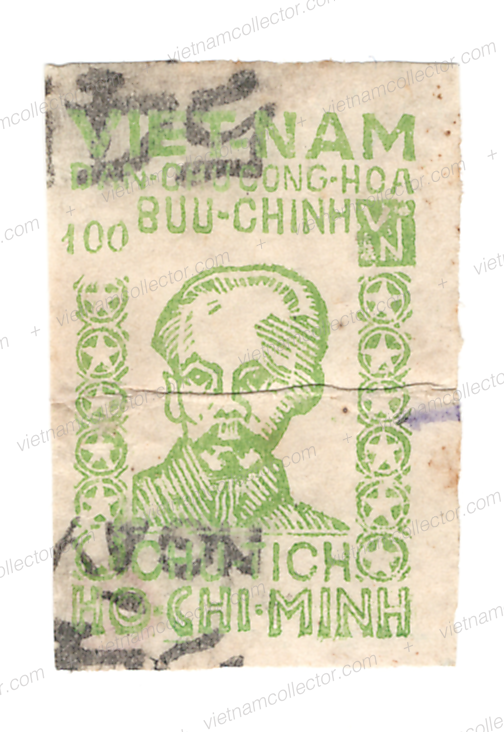
0.3kg rice on 30D on 5D mint with hinge. Small margins but not cutting into design. Tiny age spot on HCM’s forehead. Provenance: Klewitz (SICP Member), Schwirtz (SICP Member), Gebhardt (SICP Member)
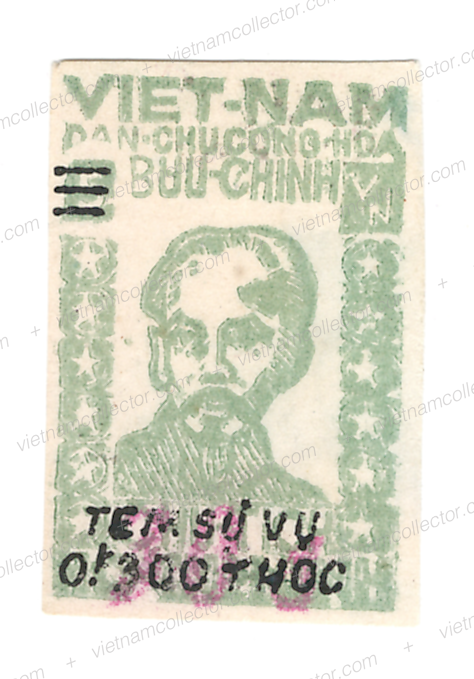
0.3kg rice on 30D on 5D used with illegible circular date canceler. Wide margins. Marked with a “L” in circle (Lucian Lu’s expert mark). Provenance: Tran Nguyen (former Postmaster of North Vietnam), Tran Trong Khai, Father Linh Bui, Lucian Lu (SICP member), Gebhardt (SICP member).
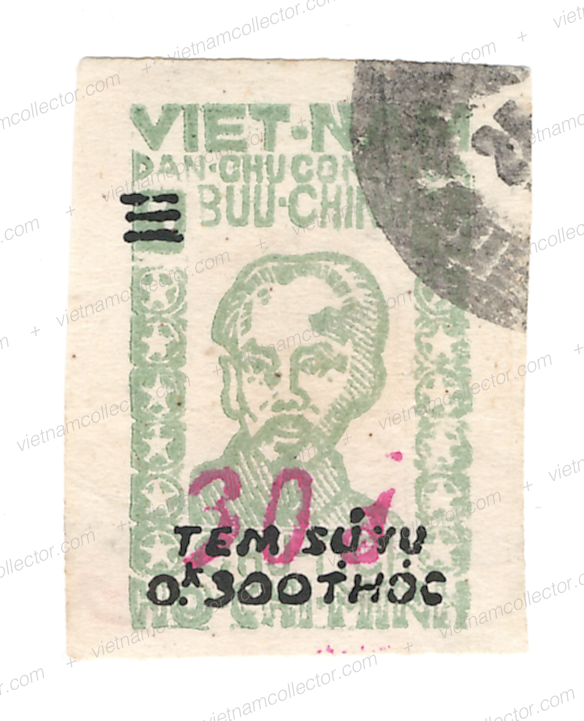
0.05 kg rice with circular canceler showing “Phu-Yen” and a date of April 4 (1953?). Hinged with a small paper thin on center back. Small paper separation not affecting the image on back. Marked with a “L” in circle (Lucian Lu’s expert mark). Provenance: Tran Nguyen (former Postmaster of North Vietnam), Tran Trong Khai, Father Linh Bui, Lucian Lu (SICP member), Gebhardt (SICP member).
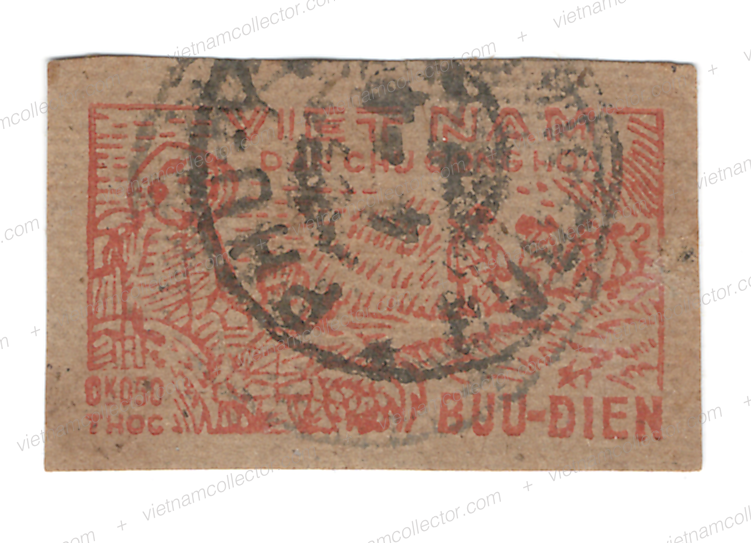
0.3kg rice used with circular canceler showing “Phong Bac”. Irregular cut. 3 wide margins but just cut into design at bottom left of the stamp. Provenance: D.Foster (SICP Member), Gebhardt (SICP Member).

Used with circular canceler “Buu Dien”. Large margins. Small paper thin on back at bottom left of the stamp. Provenance: Klewitz (SICP Member), Duering (SICP Member), Gebhardt (SICP Member).
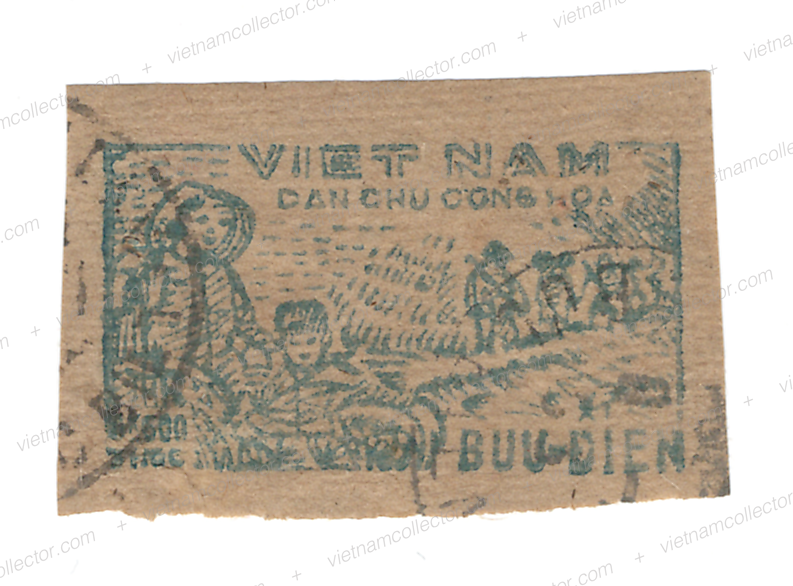
[1] J. Desrousseaux, Les Postes et Courriers Francais en Extreme-Orient, Livre 6
[2] information obtained by Lucian Lu from a collector friend in Vietnam over 20 years ago
[3] https://en.m.wikipedia.org/wiki/Treskilling_Yellow/https://en.wikipedia.org/wiki/British_Guiana_1c_magenta
[1] Information provided by Lucian Lu to the author in 2014
Lien Khu V did use stamps by the National Government when they were available and supply lines through the French lines were open. Genuine samples on or off-cover are exceedingly rare and they carry a cancel that states “Buu-Dien L.K.V. Phong Bac Biet” along with the time of day and date (often with the year missing). Here is a scan of the genuine L.K.V. cancel:

Beware of forged or misused cancels! Below is the 10D Dien Bien Phu stamp that was issued in October of 1954 (the battle itself already had ended on May 8th, 1954) and that carries a forged or misused L.K.V. cancel from February 18th, 1954. Clearly the forger did not have his/her dates lined up well as the stamp could not have been cancelled prior to the successful battle or the issuance date of the stamp.
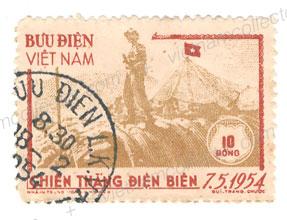
Lien Khu VI
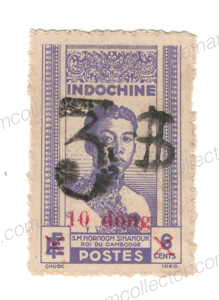
Registration Nr. 100023

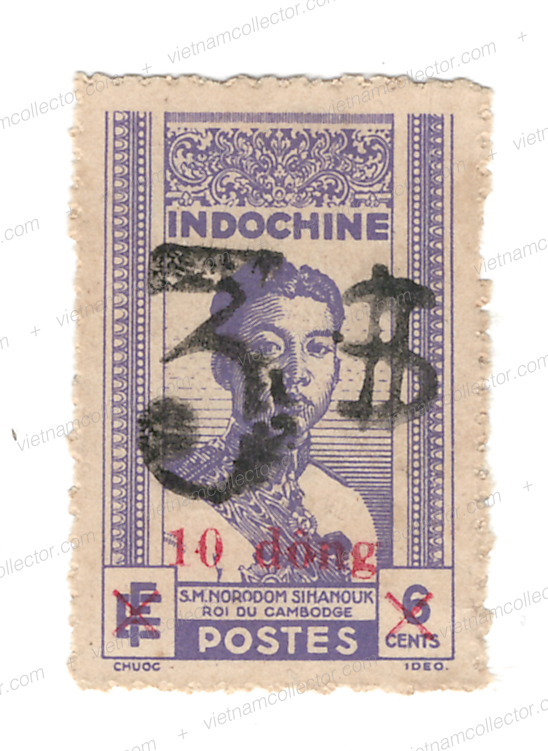
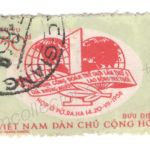



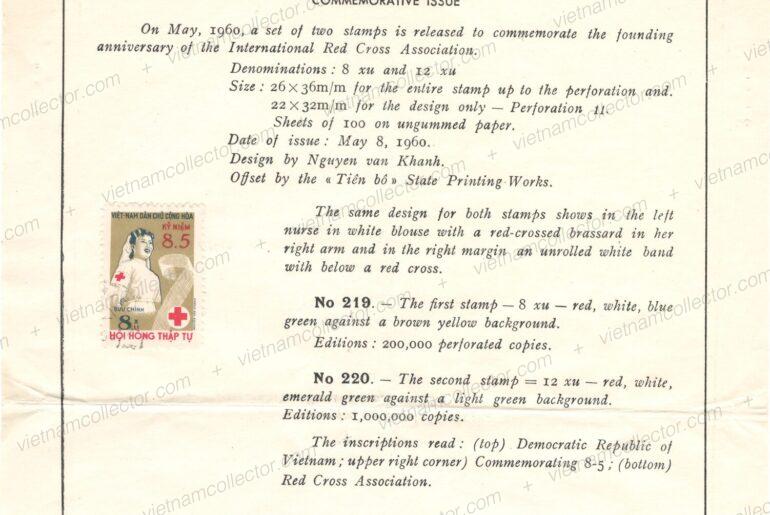
Comments are closed.